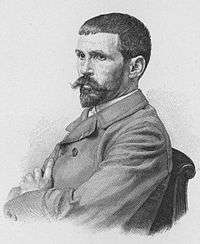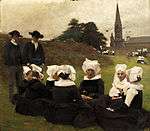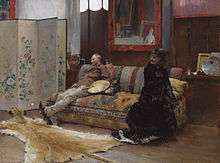Pascal Dagnan-Bouveret

Pascal-Adolphe-Jean Dagnan-Bouveret (January 7, 1852 – July 3, 1929), was one of the leading French artists of the naturalist school.
Biography
He was born in Paris, the son of a tailor, and was raised by his grandfather after his father emigrated to Brazil. Later he added his grandfather's name, Bouveret, to his own.
He became one of the leading French artists of the naturalist school and painted several paintings depicting Brittany. From 1869 he studied at the École des Beaux-Arts under Alexandre Cabanel and Jean-Léon Gérôme. From 1875 he exhibited at the Salon, where in 1880 he won the first-class medal for the painting "An Accident" and a medal of honour in 1885 for "Horses at the Watering Trough". From the 1880s Dagnan-Bouveret along with Gustave Courtois, maintained a studio in Neuilly-sur-Seine, a fashionable suburb of Paris. By that time he was recognized as a leading modern artist known for his peasant scenes, but also for his mystical-religious compositions. His large-scale painting "The Last Supper" was exhibited at the Salon de Champ-de-Mars in 1896.[1] He was one of the first to use the then new medium of photography to bring greater realism to his paintings. In 1891 he was made an Officer of the Legion of Honour and in 1900 he became a member of the Institut de France.
Selected paintings
 "Woman in Breton Costume Seated in a Meadow"
"Woman in Breton Costume Seated in a Meadow" Le pardon en Bretagne by Pascal-Adolphe-Jean Dagnan-Bouveret. Held by the Metropolitan Museum of Art. New York.[2]
Le pardon en Bretagne by Pascal-Adolphe-Jean Dagnan-Bouveret. Held by the Metropolitan Museum of Art. New York.[2] "Les Bretonnes au Pardon" by Pascal-Adolphe-Jean Dagnan-Bouveret.[3] Musée Calouste Gulbenkian. Lisbon. The painting was executed in 1887.
"Les Bretonnes au Pardon" by Pascal-Adolphe-Jean Dagnan-Bouveret.[3] Musée Calouste Gulbenkian. Lisbon. The painting was executed in 1887. "Portrait of Brittany Girl" by Dagnan Bouveret. Held in the Museum of Fine Arts
"Portrait of Brittany Girl" by Dagnan Bouveret. Held in the Museum of Fine Arts- "Head of a Woman in Breton Costume" by Dagnan-Bouveret
 Hamlet and the Gravediggers, 1883
Hamlet and the Gravediggers, 1883 In the Meadow, 1892
In the Meadow, 1892 Gustave Courtois in his Studio
Gustave Courtois in his Studio
See also
- Sara Page (1855–1943) His student.
References
- ↑ New York Times, 25 April 1896.
- ↑ "Le Pardon en Bretagne". Retrieved 30 November 2015.
- ↑ "Les Bretonnes au Pardon". Retrieved 1 December 2015.
Further reading
- Gabriel P.Weisberg. Against the Modern: Dagnan-Bouveret and the Transformation of the Academic Tradition. New York: Dahesh Museum of Art, 2002. ISBN 0-8135-3156-X
External links
![]() Media related to Pascal Dagnan-Bouveret at Wikimedia Commons
Media related to Pascal Dagnan-Bouveret at Wikimedia Commons